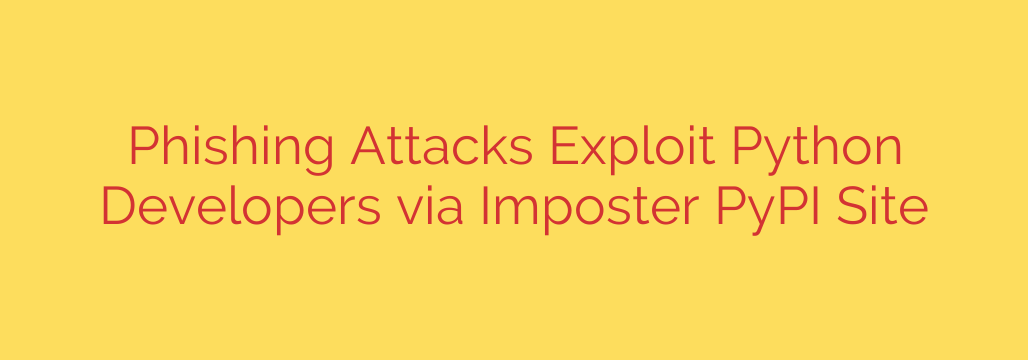
Urgent Security Alert: Phishing Campaign Targets Python Developers with Fake PyPI Site
Python developers are currently being targeted by a sophisticated and dangerous phishing campaign designed to steal credentials and compromise the entire software supply chain. This attack uses a meticulously crafted imposter website that mimics the official Python Package Index (PyPI), putting countless projects at risk.
Understanding this threat is the first step toward protecting yourself and your work. The attack is effective because it preys on the trust developers place in essential tools like PyPI. Attackers are not just trying to access individual accounts; they are aiming to inject malicious code into popular packages, potentially infecting thousands of downstream users and systems.
The Anatomy of the Attack: How Developers Are Being Tricked
The phishing scheme follows a classic but highly effective pattern, specifically tailored to the Python community. Here’s how it works:
The Bait: The attack begins with a phishing message, often delivered via email. This message is designed to create a sense of urgency, prompting immediate action. It might claim there is a security issue with your account, a required package update, or a new validation process you must complete.
The Trap: The message contains a link that directs the victim to a fake website. This imposter site is a pixel-perfect replica of the real pypi.org login page. Attackers use “typosquatting” to create convincing domain names, such as slight variations of the official URL, that can easily go unnoticed by a busy developer.
The Heist: Believing they are on the legitimate PyPI site, the developer enters their username and password. These credentials are then immediately captured by the attackers. With this access, the attackers have full control over the developer’s PyPI account and all the packages they maintain.
Why a Stolen PyPI Account is a Critical Threat
The compromise of a single PyPI account is more than just an individual security problem—it’s a potential software supply chain attack. Once attackers gain control, they can:
- Publish Malicious Versions: They can push new, malicious versions of legitimate packages you maintain. This code could contain anything from credential stealers and spyware to ransomware.
- Create a Widespread Infection: Every developer, server, and application that pulls the updated, compromised package will automatically be infected. This ripple effect can cause massive damage across the tech ecosystem.
- Hijack Reputable Projects: By taking over a trusted package, attackers leverage its reputation to distribute their malware without raising immediate suspicion.
Actionable Steps to Secure Your PyPI Account Today
Vigilance and proactive security measures are your best defense against these attacks. Simply being aware is not enough; you must take concrete steps to lock down your account and development workflow.
1. Always Verify the URL Before Entering Credentials
This is the single most important step. The official PyPI website is pypi.org. Before you log in, double-check the address bar. Look for subtle misspellings or different top-level domains (e.g., .net, .com, .io). Bookmark the correct URL and use that bookmark exclusively.
2. Enable Two-Factor Authentication (2FA)
This is the most effective defense against credential theft. Even if an attacker steals your password, they cannot access your account without the second factor (e.g., a code from an authenticator app or a security key). If you maintain any package on PyPI, enabling 2FA should be considered mandatory.
3. Use API Tokens for Publishing, Not Passwords
Avoid using your username and password directly in automated scripts or CI/CD pipelines. Instead, generate scoped API tokens for uploading packages. This limits the potential damage if a token is ever exposed, as it doesn’t grant full access to your account settings.
4. Be Skeptical of Unsolicited Emails
Treat any email asking you to log in to PyPI with extreme suspicion, especially if it creates a sense of urgency. PyPI will rarely send emails requiring immediate login for validation. If you are unsure, go directly to the official website by typing the URL yourself—do not click the link in the email.
5. Trust, But Verify Your Dependencies
Regularly audit the packages you depend on. Tools are available that can scan for known vulnerabilities or suspicious code within your project’s dependencies. A compromised package in your project is just as dangerous as a compromise of your own account.
By staying informed and implementing these security best practices, you can help protect your projects, your users, and the integrity of the open-source community. The threat is real, but a secure and vigilant developer remains the strongest line of defense.
Source: https://www.bleepingcomputer.com/news/security/hackers-target-python-devs-in-phishing-attacks-using-fake-pypi-site/








